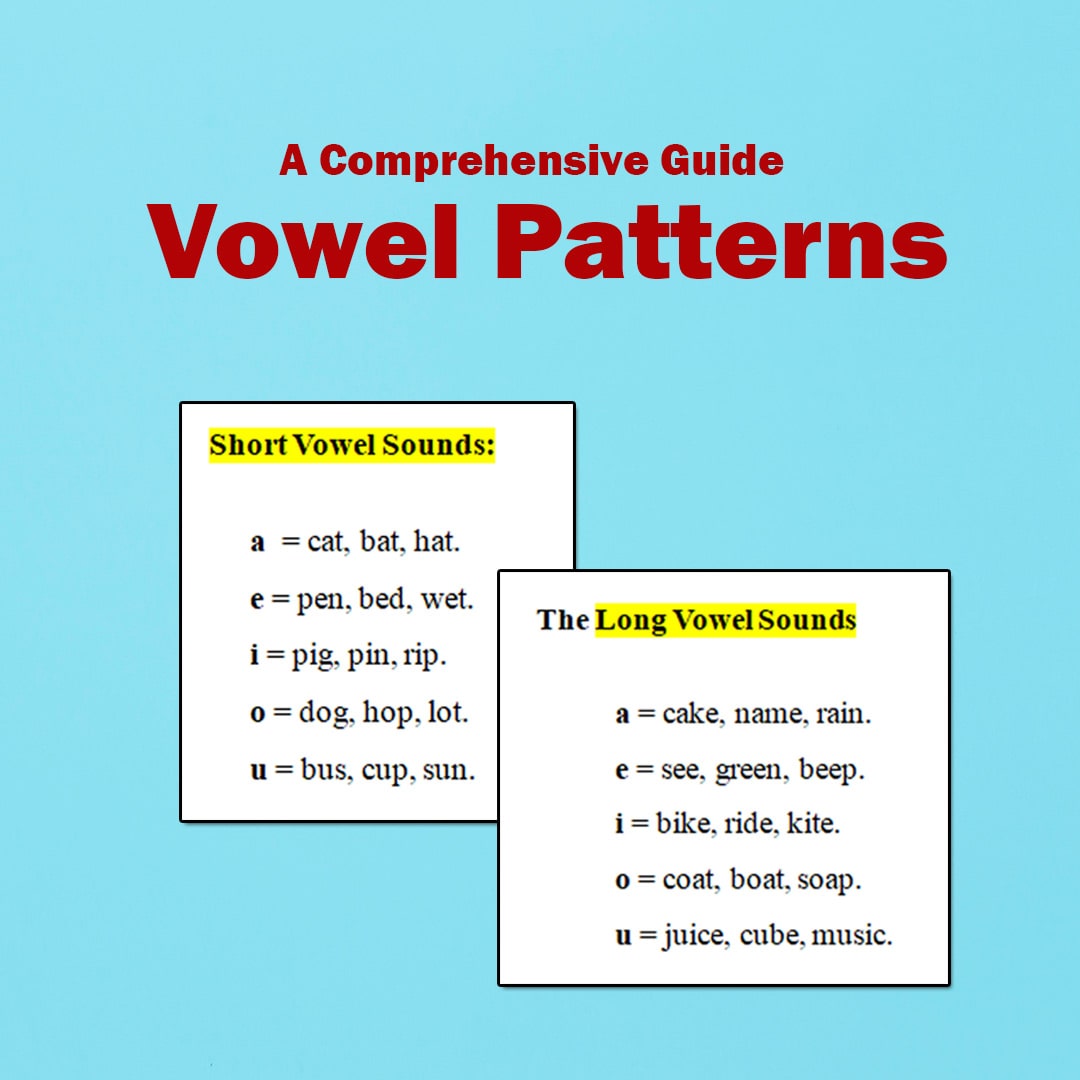

Please enter the code we just sent to whatsapp 91-11-46710500 to proceed
Didn't Receive OTP?

Ever seen your kid trying to pronounce a word while going through a book, or swapping letters when spelling? It is an issue that many kids face and vowels are often the cause. These combinations of letters might seem difficult, but don’t worry! This guide will provide you with all the tips for teaching your child vowel patterns.
English vowels are full of surprises. Unlike in other languages where vowels have fixed sounds most of the time, English language’s vowels can be deceptive. They might sound like ‘a’ in cat which lasts only for a short time or continuous ones like ‘a’ in cake. This is important information for spelling words correctly as well as understanding them.
These vowels have a quick and plain sounds as heard in these words:
a = cat, bat, hat.
e = pen, bed, wet.
i = pig, pin, rip.
o = dog, hop, lot.
u = bus, cup, sun.
Sometimes, they come together and make the same short sound. These are referred to as short vowel patterns. Here are some of the most commonly used ones:
CVC: This is a basic pattern with Consonant-Vowel-Consonant. Examples include "cat," "bed" or "hop."
CVCC: For these patterns, another consonant is added at the end like “rank,” “jump” or “milk.”
Long vowels enjoy making their sounds longer and completely different from what was said before. There is a difference between “a” in cat and cake. Here are a few examples of long vowel sounds:
a = cake, name, rain.
e = see, green, beep.
i = bike, ride, kite.
o = coat, boat, soap.
u = juice, cube, music.
Unlike the short vowel team, long vowel sound is always a puzzle. They use a variety of tricks or “patterns” to hide their real sounds. Here are some of the most common deceptive long vowel sounds you'll meet:
Silent E: This deceptive “e” itself doesn’t sound but extends the previous vowel sound as in "cake," "bike," and "cube."
Vowel Teams: Two or three vowels can marry to form one long sound such as “ai” in “rain,” “ee” in “green,” or “oa” in boat.”
One Vowel, Bossy Job: At times, when there is only one vowel in a closed syllable (a syllable that ends with a consonant), it may be given a chance to make a long sound like in rip versus ripe.
This famous rule says that mostly letter e makes the long e sound when followed by i except after c. Therefore, you have bike and kite but mice (pronounced as mice). Nonetheless, English language has many deviations from the norm such as weird and neighbour. It is better if this rule is treated as an aid not certainty.
Read more: 20 Short Moral Stories for kids in English | Valuable Lessons
Picture a young knight Finn out to conquer the mysterious Vowel Kingdom. In his quest, he first finds himself in Short Vowel Words Valley and hears funny words like “cat” and “bug” in the air. It is at this point that Finn realizes the importance of having separate vowel sounds pronounced quickly.
He then enters Long Vowel Words Forest where magical trees whisper words like “rain” and “boat.” Here, Finn becomes friends with Silent E fairies who make vowels longer, as well as Vowel Team pixies who join together to create some new ones. Sometimes he also comes across Bossy Vowels which are single letters standing tall and strong thus making their long sound distinctly heard.
Deeper into the journey, Finn discovers the difficult “I before E” cave. A wise old owl that lives here explains it using examples such as "bike" and "kite." However, he also tells Finn to be careful of exceptions like “weird” and “neither.” This is because, he says, vowels have a tendency to behave in unpredictable ways; therefore, one must approach them like a detective who follows rules but is prepared for anything.
Eventually, Finn arrives at the Vowel Castle where he demonstrates his mastery of all vowel patterns and English spelling rules. He can identify words whether they are long or short or easy or hard. The King and Queen of Vowel Land are impressed by him and rejoice over his accomplishment. They remind him that practice makes perfect when it comes to vowel power; this means having fun with language and indulging in other forms of linguistic expression.
Read more: Making Verbs Easy for kids: Exploring the Action Words
Just like Finn, your child can master vowels with a little practice and exploration. Below are some suggestions that you can use to create your own fun learning activities. Remember that creating a love for reading and writing is the most important thing and vowel patterns will fall into place naturally.
Learning vowel patterns doesn’t have to be boring drills. Here are some ways to make it an enjoyable experience rather than just an ordinary drill that will keep your child coming back for more:
Short Vowel Jamboree: Find catchy tunes such as "Twinkle, Twinkle Little Star" and replace their words with short-vowel words. This is how:
“Cat, cat, little cat, sitting on the mat. A, a, a, a, . . . Is that a short sound?”
Long Vowel Parade: Choose a familiar marching song and rewrite the lyrics to focus on long vowel sounds. You can even add actions for each sound!
“We’re marching with the long A sound way up high! (Reach arms high) Cake, name, rain they all fly by! (March in place)”
By integrating these enjoyable activities into your child’s learning routine, you can change from being obstacles to playful adventures in terms of vowels sounds. The key is to make sure things are exciting; celebrate their improvements and develop an eternal passion for language within them.
Word Chain Challenge: On several pieces of paper, write words with short vowels. Then pick the words and build chains in such a way that one ending sound becomes the onset for the next word in line. For example, “cat” – “hat” – “tap” -“pet.”
Magnetic Match-Up: Buy some magnetic letters. Write short vowel patterns on a baking sheet and let your child find letters which match them to make words.
I Spy with My Little Eye: Find things around the house that have different vowel sounds taking turns. “I spy with my little eye something that rhymes with ‘bike’ (like ‘like’)”
Rhyme Time: Select books rich in rhyming words and read aloud emphasizing the rhyming sounds. Encourage your child to participate by mentioning rhyming words they know.
Sound Detectives: Turn reading into a detective game! Ask your son or daughter to listen for certain vowel sounds throughout the story. Whenever they hear the target sound, they can clap their hands, raise a finger or do something funny.
Silly Sentences: After finishing a book have fun developing silly sentences together. Use words from the book or make up their own using particular vowel patterns.
Playing with Patterns: Start with a single word, “cake” and have your child add rhyming words or other words with the same pattern on consonants to create a funny sentence. For instance, “Cake, bake, a silly mistake!”
Mad Libs Fun: Be creative with Mad Libs or form your own fill in the blank stories. You can use blank spaces specifically for vowel patterns in order to encourage focused learning.
Flashcard Fun: Write short vowel words on bright colored flashcards then play hide them all around the house at different places. Whenever you find one of those cards direct him/her to read the word and say what its vowel pattern is.
Treasure Hunt: Develop a list for a treasure hunt that includes clues using certain vowel pattern words. Like “Find something you wear on your feet that has a short ‘e’ sound” (answer: sock).
Through some patience, a touch of ingenuity and using this guide as your guide post; you can unlock the mysteries of vowels in your child and let them enjoy a lifetime full of reading and writing adventures!
Shape Your Kid's Future with Bambinos Classes | Bambinos.live India's No. 1 English Communication Platform For Kids | Book a Free Class Now